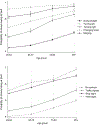Predictors of driving errors contributing to crashes in older adults across age groups, 2010 to 2020
- PMID: 39986859
- PMCID: PMC11847146
- DOI: 10.1016/j.jsr.2024.11.010
Predictors of driving errors contributing to crashes in older adults across age groups, 2010 to 2020
Abstract
Introduction: Given the largely autocentric nature of the United States, drivers continue to operate vehicles with varying levels of driving ability and self-restriction as they advance into older age. This study explores the associations of vehicle actions and traffic control devices with older drivers' driving errors contributing to crashes, incorporating age group as effect modifiers of these relationships.
Method: This study includes crashes reported to the Iowa Department of Transportation from 2010 to 2020. Analysis was completed for drivers involved in a crash who were aged 45 years and older (n = 254,912). Driving errors were identified based on driver contributing factors reported in the Iowa crash data. A multivariable logistic regression model was built to model predictors of driving errors, focusing on crash-related vehicle actions and traffic control devices. Additionally, interaction terms were incorporated to examine the moderating effect of age groups (45-64; 65-74; 75-84; 85+).
Results: Driving errors increased with age, especially in the middle-old age group (75-84). A higher probability of driving errors was observed in changing lanes, merging, and turning, with right turns showing the most substantive increase in the middle-old age group compared to the other age groups. Stop and yield signs were associated with a higher probability of driving errors, increasing monotonically with age. The middle-old age group exhibited a notable increase in driving errors at uncontrolled or traffic signaled locations compared to the other age groups.
Conclusions: The significant increase in driving errors at and beyond the middle-old age group may demonstrate higher age-related declines in safe driving compared to younger age groups.
Practical applications: Careful evaluations for older drivers' fitness to drive during license renewal periods are needed once drivers reach the middle-old age. Additionally, effective combinations of advanced technologies, traffic systems, and policies are necessary to reduce the burdens associated with aging.
Keywords: Aging; Fault; Intersections; Road safety; Traffic.
Published by Elsevier Ltd.
Conflict of interest statement
Declaration of competing interest The authors declare that they have no known competing financial interests or personal relationships that could have appeared to influence the work reported in this paper.
Figures
References
-
- Adanu EK, Lidbe A, Tedla E, & Jones S. (2021). Factors associated with driver injury severity of lane changing crashes involving younger and older drivers. Accident Analysis & Prevention, 149, 105867. - PubMed
-
- Af Wåhlberg A. (2009). Hourly changes in accident risk for bus drivers. Journal of Risk Research, 12(2), 187–197.
-
- af Wåhlberg AE, & Dorn L. (2007). Culpable versus non-culpable traffic accidents; what is wrong with this picture? Journal of Safety Research, 38(4), 453–459. - PubMed
-
- Alvarez FJ, & Fierro I. (2008). Older drivers, medical condition, medical impairment and crash risk. Accident Analysis & Prevention, 40(1), 55–60. - PubMed
MeSH terms
Grants and funding
LinkOut - more resources
Full Text Sources


